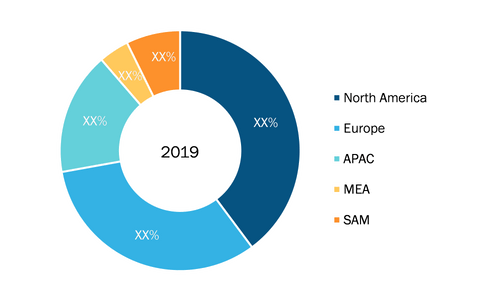According to our latest market study on "Algae Products Market Forecast to 2027 - COVID-19 Impact and Analysis- by Source (Brown Algae, Blue-Green Algae, Red Algae, Green Algae, Others),Type (Lipids, Carrageenan, Carotenoids, Alginate, Algal Protein, Others),Form (Solid, Liquid),Application (Food and Beverages, Nutraceuticals and Dietary Supplements, Personal Care Products, Feed, Pharmaceuticals, Other),and Geography," the market was valued at US$ 2,405.5 million in 2019 and is projected to reach US$ 4,339.3 million by 2027; it is expected to grow at a CAGR of 7.8% from 2020 to 2027.
Algae are the base of the aquatic food chain and major supplement of food and energy in the modern food industry. Marine algae are a rich source of minerals, vitamins, and proteins, and are considered as super foods. Spirulina is an example of algae widely used as food and nutritional supplement in human and animals. They are known to boost the immune system, lower cholesterol levels, and improve memory. Algae are rich in antioxidants and carotenoids, and are, hence, extremely useful in nutraceuticals and dietary supplements. Algae are manufactured into powder, tablets, and liquids. In addition, algae can have high biofuel yields. The algae products market is anticipated to grow during the forecast period owing to driving factors such as rising consumer awareness regarding health benefits of algae-based products coupled with rising demands for natural ingredients. Growing applicability in multiple industries such as pharmaceuticals and food &beverages further fuels the growth of the algae products market.
North America and APAC are currently dominating the algae products market, together accounting for ~63% of the global market. In the US and other parts of the world, algae are commonly used as an ingredient in dietary supplements to help boost the immune system, repair nerve tissue, normalize blood sugar, and provide added protein and fiber to the body. Algae have been harvested in China and Japan for use as human food for more than 4,000 years. In APAC, the market for algae products is driven by the growing consumption of seaweed for fast muscle recovery and weight control. An increase in glucose intolerance and upsurge in demand for gluten-free products are other factors rising the demand for algae-based flour. Moreover, expansion and diversification of the application base of algae are opportunistic for the growth of the APAC algae products market. European countries are becoming more health conscious, which has, in turn, increased the demand for algae products. Eastern Europe witnesses' significant growth in the consumption of algae products, and the market in Eastern Europe registers substantial growth, followed by the Middle East and Africa, and South America.
In North America, the growing interest of consumers in consuming nutritional and protein-rich alternatives as a result of increasing trend toward a healthy lifestyle has enabled the manufacturers in North America to incorporate high-quality algae-based edibles. Growing environmental concerns and upsurge in awareness toward health issues and animal feeds have shifted the focus on to alternative supplements derived from different species of algae. Algae supplements comprise compound ratio, which varies from potential weight loss to antioxidant effects. Easy acceptance of these supplements in North America, along with its economic nature and high protein and nutritional content, is likely to favor the demand for algae products in North America during the forecast period.
Impact of COVID-19 on Algae Products market
The US has the highest number of confirmed cases of coronavirus, as compared with Canada and Mexico. COVID-19 pandemic continues to affect various industries in North America, and is directly affecting the spending. According to the Center for Strategic and International Studies, the US would experience contraction in GDP in the second quarter of 2020 owing to COVID-19 impact. Further, as per the United Nations Conference on Trade and Development (UNCTAS), foreign direct investment (FDI) flows could fall between 5% and 15% to their lowest levels since the 2008-2009 financial crisis. However, marine red algae may hold the key to prevent the spread of coronavirus as biocompatible compounds extracted from them can be used as a coating material on sanitary items. Canadian researchers use algae to develop serological test kits for COVID-19 that are low-cost. It helps determining the novel coronavirus infection in a suspect.
Algae Products Market Breakdown - by Geography, 2019

Algae Products Market Research Report by 2027
Download Free SampleAlgae Products Market Forecast to 2027 - COVID-19 Impact and Global Analysis by Source (Brown Algae, Blue-Green Algae, Red Algae, Green Algae, Others), Type (Lipids, Carrageenan, Carotenoids, Alginate, Algal Protein, Others), Form (Solid, Liquid), Application (Food and Beverages, Nutraceuticals and Dietary Supplements, Personal Care Products, Feed, Pharmaceuticals, Other), and Geography
The report segments the global algae products market as follows:
Global Algae Products Market - By Sources
- Brown Algae
- Blue-Green Algae
- Red Algae
- Green Algae
- Others
Global Algae Products Market - By Type
- Lipids
- Carrageenan
- Carotenoids
- Alginate
- Algal Protein
- Others
Global Algae Products Market - By Form
- Solid
- Liquid
Global Algae Products Market - By Application
- Food and Beverages
- Nutraceuticals and Dietary Supplements
- Personal Care Products
- Feed
- Pharmaceuticals
- Other
By Geography
- North America
- Europe
- Asia Pacific (APAC)
- Middle East and Africa (MEA)
- South America (SAM)
Contact Us
Phone: +1-646-491-9876
Email Id: sales@theinsightpartners.com